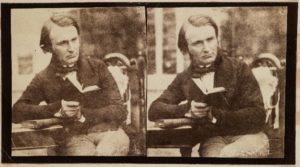On Monday 16 April 1838, a group of men met in the University Library at St Andrews, with Robert Haldane, mathematician, theologian, and Principal of St Mary’s College, chairing the meeting. By his side was David Brewster, the Principal of the United College, and although these two men did not always agree on matters of religion, they, along with 35 other “Gentlemen connected with the University and the City of St Andrews” paid half a guinea each to support the foundation of a new Literary and Philosophical Society, to promote research and to found a museum in the university.

What kind of museum?
The first meeting appointed the first curator for the new museum, John Adamson, a physician and pioneer of early photography. The Society quickly got to work, and by the time of the first general meeting of the Society in the Library on 7 May, there had already been “numerous donations” to the museum by members. On 4 June David Brewster reported that the United College would provide a room to be fitted out and used as a Museum, and by October of the same year the Society’s meetings had moved there. Soon, with a rapidly-growing collection, members of the Society began to think about the possibilities for access to the museum, including for university classes to be held in there in the future. They weren’t yet clear whether it would be (as the minutes put it) “more of a character of a University, than of a Private, museum”, but whichever it was, in the first few years it didn’t seem that the Society had a clear sense of the potential public audience for the collections and displays.
Fishermen and tradesmen
By the 1850s, the Museum was open to members of the Society, to professors and their classes, and to students studying the collection, and it also opened on Saturdays in summer for the public. Evidently relishing the way public access had brought interesting things to him for the collection, Curator John Adamson reported in 1855 that since the Museum had been “thrown open to the fishermen” the Society had been given some interesting specimens for the collection. The same year, he proudly noted that as many as 247 people had visited on one afternoon, and that “many tradesmen” had as a result begun to study natural history. The following year, in summer 1856, interest was similarly strong but the curator’s report had a note of caution: there had been damage done, by accident, because of the number of visitors. They were in future to be asked to leave sticks, parasols, and umbrellas outside rather than bringing them into the museum to protect the Museum and its collection.

A penny or two
All was not, however, well with the Society’s finances despite this growing public interest in the Museum. The University had already had to contribute to the costs of taking care of the collection, and from 1857 the Society introduced admission fees for the Museum. Members of the Society were still admitted free with up to five guests, students of the University were admitted free on Saturday, and special arrangements were made for professors and their classes to use the museum. School pupils were welcome on Wednesdays and Saturdays, as long as they were accompanied by a teacher or tutor, and they paid 1 penny each, with general admission for the public charged at 2 pence each.
Fast forward to today
Fast forward more than 150 years, and the Museums of the University of St Andrews no longer charge entry fees, and the Wardlaw Museum and Bell Pettigrew Museum are currently temporarily closed due to the impact of coronavirus Covid-19. This April, the Museums team are celebrating the birthday of the Literary and Philosophical Society and its museum. Whether you are a student, fisherman, tradesman, school pupil, or anyone else, we look forward to welcoming you to the Museums when we’re able to reopen. But we might still ask you to leave your umbrella at the door, to protect the collections and objects on display, among them some of the ones that were acquired by the Literary and Philosophical Society for its collections 182 years ago.
The first volume of the minutes of the Literary and Philosophical Society (1838-1861) has been digitised by the University of St Andrews Library. If you would like to learn more about the society, click here to view the minutes online.
Dr Katie Eagleton, Director of Museums